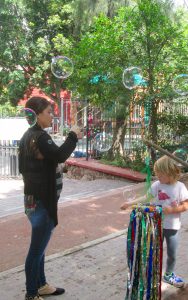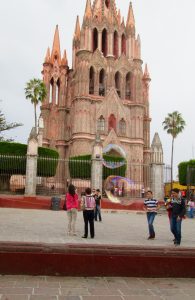Everywhere you go here in San Miguel de Allende, wherever little children are free to romp and play and squeal delightedly – such as in the lush Parque Juarez or the glorious Jardin (plaza) near the grand Parroquia church in el centro – you see vendors selling bubbles.
What is it about bubbles that captivates kids so? Their lighter-than-air-ness? Their iridescence? Their shape-shiftiness? Their delicacy? They seem so not-of-this world, evanescent; yet there they are, emerging from the bubble-maker’s wand – floating like mini-blimps, chase-able, breakable. Just watch a tiny boy try his best to break one.


I’ve been thinking a lot about bubbles lately, as I take walks in the park and jardin: Bubbles are for children’s delight; yet it seems that countless American adults are living in them these days. How else, I wonder, can you explain what’s going on in the political arena in the U.S.?
It’s mind-boggling, at least to me, that any thinking person could believe that a man so totally unqualified and unprepared to be President of the United States should even have the gall to attempt to win that position, much less be supported in doing so. I think: What are they thinking? And: Are they thinking? They must be living in bubbles.
I’ve been striving to understand this baffling phenomenon. I learned in the media that among Trump’s hoards of supporters are evangelical Christians and whites who have not been to college. Well, I’ve been there! I say to myself.
Long, long ago, when I was an earnest adolescent, I attended an evangelical church, so I know from the inside what that particular pretty bubble is like. And I didn’t graduate from college until I was in my early thirties, so I know well how it felt to be that kind of outsider.
When World War III was raging at home in the lead-up to my parents’ divorce, when I was in junior high and high school, I went alone to a church in a nearby town. As I wrote in my memoir Somewhere Child (Viking Press, 1981):
“I went to that church faithfully, hungrily: to the Sunday school classes, the morning worship services, the evening youth group meetings, the evening services. I went for the music – Bach in the morning and gospel songs at night – for the Bible lessons, for the warmth of the people, for the messages of love and peace. . . . I went to escape the strife at home and find a haven with the promise of Heaven.”
I remember one of the hymns we sang, enthusiastically:
“This world is not my home, I’m just a-passin’ through. My treasures are laid up somewhere beyond the blue. The angels beckon me from Heaven’s open door, and I can’t feel at home in this world any more!…”
The people of that church then – not unlike evangelicals today, I’m sure – were kind, generous, and hospitable. I spent time at their homes (avoiding the war zone of my own) and learned from their example how to be a good, God-fearing person.
I will always be indebted to them for rescuing me; at that pivotal time in my life, with no guidance from home, I could easily have succumbed to the wrong crowd. But I knew even then that these sweet people could not have imagined the violent day-to-day reality of my real home life. They lived in a pretty bubble.
I remember, too, one loving couple from that church offering to give me enough money to attend a Bible college when I graduated from high school. I thanked them kindly but declined their offer. I knew even then that what I needed was higher education, not more indoctrination.
Ultimately, at the age of thirty, I applied for and won a full merit scholarship to Columbia University in New York, where I learned, most of all, how to think for myself. I remember clearly reading Immanuel Kant’s essay, “What is Enlightenment?” and the powerful effect it had on me. In the first paragraph of his essay, Kant begins to explain:
“Enlightenment is man’s emergence from his self-imposed nonage [the period of legal minority or youth]. Nonage is the inability to use one’s own understanding without another’s guidance. This nonage is self-imposed if its cause lies not in lack of understanding but in indecision and lack of courage to use one’s own mind without another’s guidance. Dare to know! (Sapere aude.) ‘Have the courage to use your own understanding,’ is therefore the motto of the enlightenment….”
Nonage is a “comfortable” state, Kant claims. “If I have a book that thinks for me,” he writes, “a pastor who acts as my conscience, a physician who prescribes my diet, and so on — then I have no need to exert myself. I have no need to think…” (For the entire essay, go to the Columbia University link: www.columbia.edu/acis/ets/CCREAD/etscc/kant.
Nonage is another bubble. I’ll be eternally grateful that the education I received at Columbia University in the ‘70s broke through mine. Reality, I’ve learned, is seldom bubble-pretty or bubble-light; in fact, it’s often heavy and hard-edged. But it’s necessary to face it.
Bubbles are for children. Responsible adults must use their own, God-given minds to think. We’re not in Heaven yet. While we are alive as corporal beings, we ARE citizens of this world, and this world IS indeed our home. Too much is at stake now, I believe, to think otherwise.
